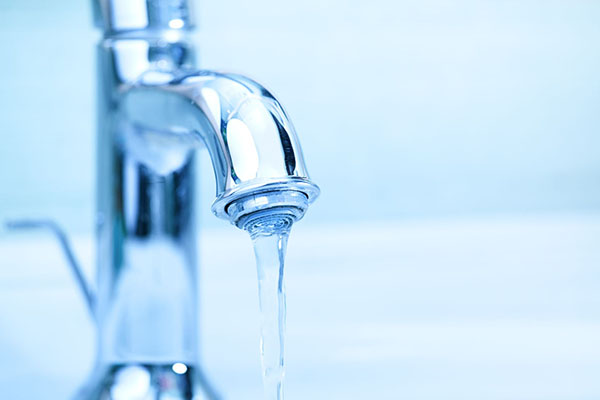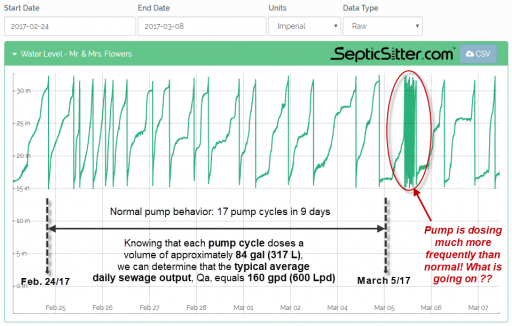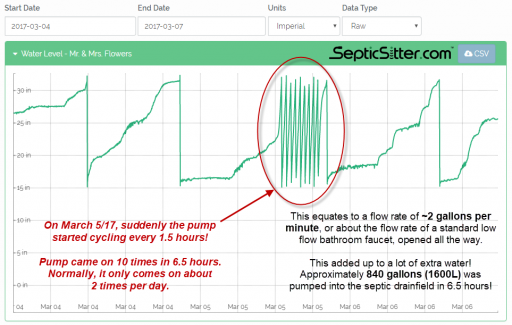
With the advent of modern remote septic monitoring and alert systems, homeowners don’t need to fall victim to “sneaky leakies” that can cause hydraulic overloading if left undetected. Following is a case study of how excessive water usage was detected and corrected before the septic system turned into a swimming pool.
Case Study
Mr. & Mrs. Flowers’ (not their real name) residential septic system consists of a raised-bed, EZflow drainfield which is demand-dosed with septic tank effluent by a pump. The following screenshot from the SepticSitter web application shows liquid levels in the pump chamber every five minutes during the period Feb. 24 to March 8.
Up until March 5, the pump dosing frequency was fairly normal, and there were 17 pump cycles in 9 days. Each pump cycle has a volume of approximately 84 us gallons (317 L), so the average daily sewage output during this time was about 160 gpd (600Lpd).
However, suddenly on March 5, the pump chamber started filling up rapidly. As the next screenshot (zoomed in on the time around March 5) shows, the pump needed to come on 10 times in 6.5 hours to keep up with the flow. Prior to this, it was only coming on about twice per day.
This added up to a lot of extra water getting pumped into the septic drainfield, about 840 gallons (1600L) in 6.5 hours! This was equivalent to a flow rate of 2 gallons per minute, which is about the flow rate of a standard low-flow bathroom faucet, opened all the way.
When this unusual pump activity was detected, the homeowners and their septic service professional were alerted. The excessive water output from the home was quickly and easily corrected before untreated sewage started breaking out on their lawn, which avoided having to fix a costly public health and environmental mess.
Go Low Flow!
In addition to the risk of septic overloading, homes and businesses on central water supply systems pay for every gallon of water that they use, so leaky or non-water efficient fixtures can end up costing a lot of money in extra water going down the drain. Even if your fixtures aren’t leaking, you will help protect your septic system from hydraulic overloading and potentially extend its life by retrofitting old fixtures, toilets and washing machines with modern, ultra water efficient models. In case you are wondering how to determine the flow rate from any of the fixtures in your home, this article by Bob Formisano describes how to do it.
If you are monitoring your septic drainfield levels with SepticSitter, you will likely see the beneficial effects of your reduced water consumption (reduced sewage output) in the before-versus-after drainfield ponding levels. As a bonus, if you are paying for all the water you consume, you will also save money on your water bill and hot water heating costs.
So fix those “sneaky leakies” and go low flow!



Comment